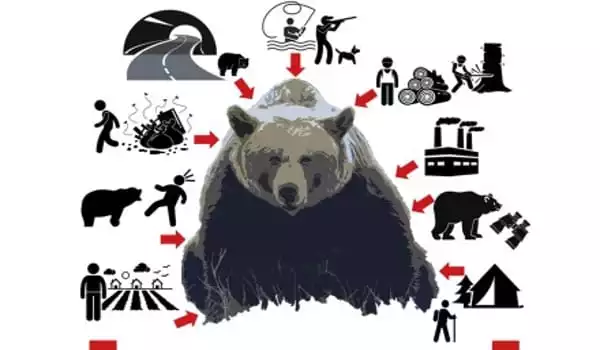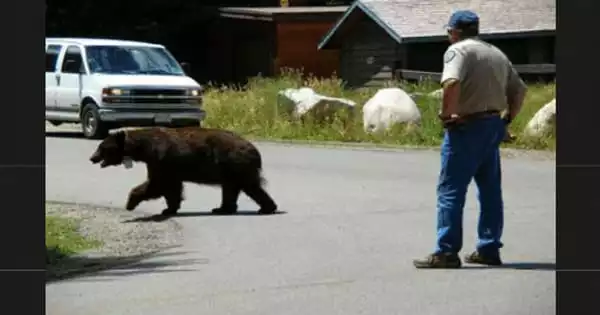Conservationists have long warned of the dangers of bears becoming accustomed to life in cities. However, it appears that the message has not reached everyone. News reports continue to cover situations that appear to be similar: a foraging bear enters a neighborhood, easily finds high-value food, and refuses to leave. Often, conservation officers are forced to euthanize the animal for public safety reasons.
News reports continue to cover situations that appear to be similar: a foraging bear enters a neighborhood, easily finds high-value food, and refuses to leave. Often, conservation officers are forced to euthanize the animal for public safety reasons.
A new study from the Irving K. Barber Faculty of Science looks at the best strategies for reducing human-bear conflict using computer modeling. “It happens all the time, and unfortunately, humans are almost always to blame,” says Dr. Lael Parrott, co-author of the study.
Dr. Parrott and a team of researchers, including master’s student Luke Crevier, created a computer model to simulate bears’ journeys within a specific urban area in order to reduce the number of conflicts. Their mission was to figure out the best way to keep bears out.
Conservationists have long warned of the dangers associated with bears becoming habituated to life in urban areas. Yet, it appears the message hasn’t gotten through to everyone.
The team collaborated with Margo Supplies, a wildlife management technology solutions company based in High River, Alberta, to investigate the resort municipality of Whistler. Researchers were able to simulate the movement of black bears in and around Whistler using agent-based computer modeling, identifying potential attractants luring them in.
“Our model allows us to drop in large amounts of data, such as the spatial characteristics of the landscape, movement patterns collected from GPS tracking of real bears, and other important information to essentially create a virtual landscape,” Crevier says. The issue, he adds, is that bears are drawn to what researchers refer to as anthropogenic food, which is easily accessible food sources such as human garbage, berries, or fruit.
“We were able to track the model bears as they moved through the landscape and interacted with various software cells that represented anthropogenic food, vegetation, and human deterrents. With the ability to input all of these proxies, we were able to better understand where they were roaming and why, as well as test different strategies within the simulation to find the most effective way to keep them out.”

The findings of the study confirmed the team’s expectations that combining attractant reduction and human deterrent strategies was the most effective way to keep bears away. When only one strategy could be used, reducing attractants proved to be the most effective.
“These findings confirm that the most commonly used management strategies are, in fact, the most effective,” Crevier says. “What was really interesting was how the model enabled us to identify attractants that we might not have considered otherwise, such as human garbage or large amounts of berries on private land within city limits.”
Because of a bear’s intelligence and memory, reducing the availability of anthropogenic food is thought to be more effective than reactive management strategies that aim to deter bears when used alone.
“Using deterrents like bear bangers may be effective temporarily in that the bear will become frightened and flee, but they will not be gone for long,” Dr. Parrott explains. “They’ll remember being scared, but their memories of the delicious meal will outweigh their fear.”
Though Whistler was chosen as the study location due to the high number of black bears that visit the town, Crevier believes that the same type of modeling can be used in communities across Canada that are experiencing similar issues.
“What’s cool about this model is that it allows us to see how different management strategies interact with one another, and this type of model can also be used to better understand the movements of other large predators like cougars or wolves,” he adds.
Dr. Parrott emphasizes the importance of learning how to coexist with wildlife in a way that is safe for everyone – including the animals. While some people may not think twice about killing a neighborhood bear, the practice has far-reaching consequences.
“We know that bears that come into communities are often juvenile or female bears with cubs, because the large males have already established their territories and have all the ‘good spots,'” she explains. “This is cause for concern because it indicates that the females are teaching their cubs how to access anthropogenic food.” It also means that because these are the bears that are most frequently euthanized, we are selectively eradicating a subset of their population.
The findings of this study and similar agent-based models provide conservationists with another tool in their toolbox to assist communities in reducing the number of bears entering urban areas, thereby reducing the number of bears killed and putting a stop to these troubling trends.”
The Natural Sciences and Engineering Research Council of Canada provided funding for this study, which was recently published in Ecological Modelling.
















